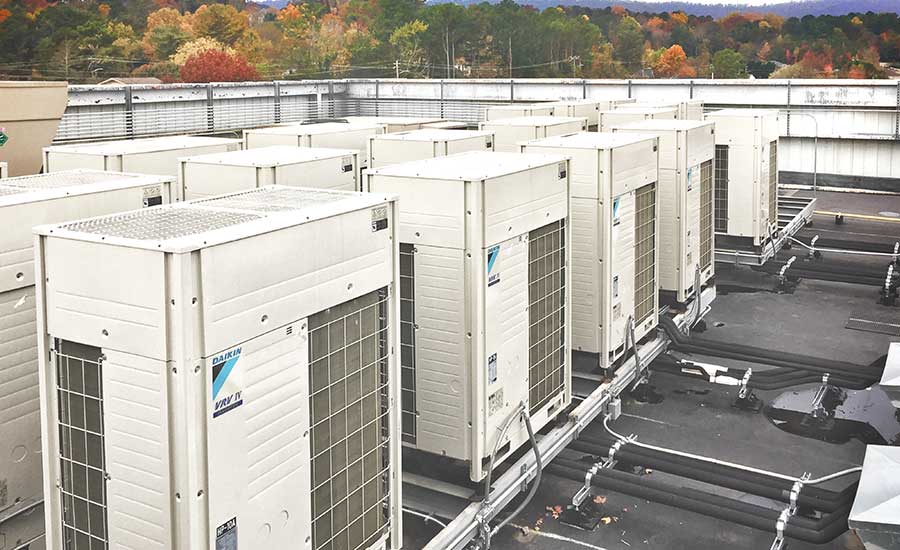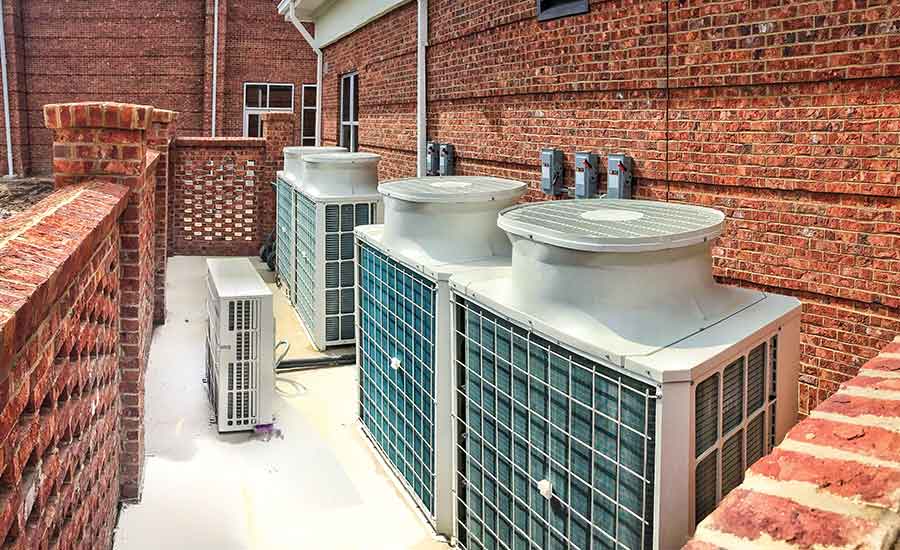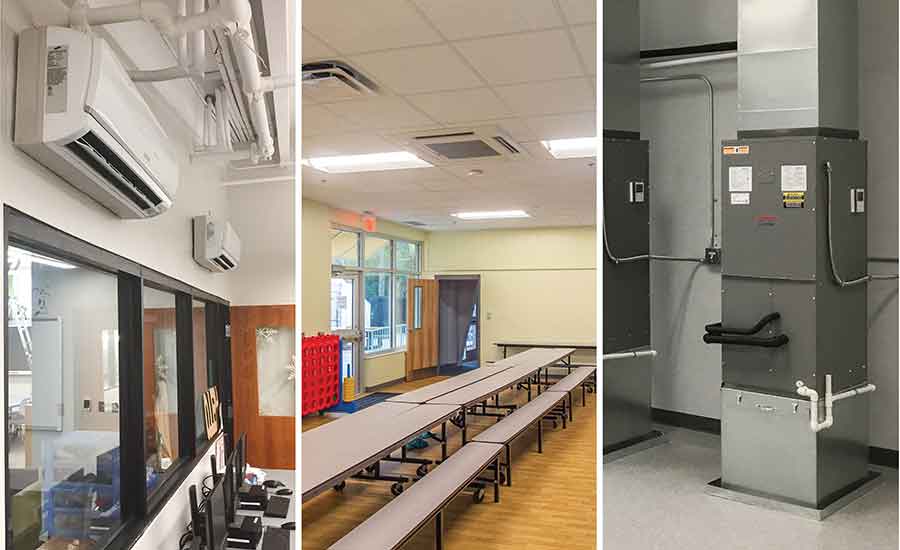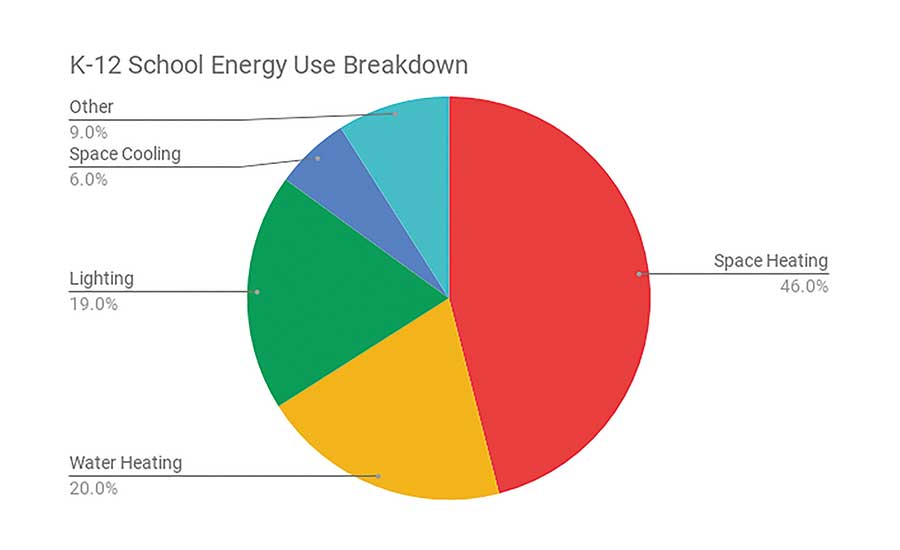Today’s school facility directors are being asked to do more with less. With limited budgets, they are pressured to reduce operating expenses while maintaining healthy and comfortable learning environments for students. Growing student populations, aging buildings, and rising energy costs only complicate the matter further. School districts are actively looking for HVAC solutions that will save energy and reduce maintenance while providing high levels of comfort and controllability. When properly designed, VRF systems provide increased energy efficiency, reliability, and zoning control to meet the requirements of K-12 school districts.
Energy Efficiency
K-12 schools in the U.S. currently spend about $6 billion on energy annually, making energy the second highest expenditure for schools after personnel costs. The U.S. EPA estimates that $2 billion of that total can be saved by improving energy efficiency. In a typical school building, space heating and cooling, lighting, and water heating represent a bulk of total energy use, making them ideal targets for energy reduction. When evaluating cost-saving measures, selecting an energy-efficient HVAC system is a top priority.
VRF systems that provide heat recovery between multiple zones are one of the most versatile and energy-efficient system types. There are multiple factors that contribute to the energy efficiency performance of VRF equipment. These systems use variable-speed compressors to modulate capacity for excellent full- and part-load performance. Compared to traditional compressors that are either operating at full power or are off, inverter-driven compressors have the ability to adjust compressor speed to match space heating or cooling loads and maintain more accurate set point temperatures. Systems should be designed with a mix of interior and exterior zones, zones with opposite exterior exposures, or spaces with differing use schedules to take advantage of heat recovery and simultaneous heating and cooling. An optimized VRF system is zoned for a diverse load profile.
Fan energy is also greatly reduced with VRF systems. By providing multiple zoned indoor units with ECM motors and low or zero external static pressure, there is no longer a need for a large central fan and duct system. Centralized ductwork will be limited to the ventilation system, and duct sizing will be greatly reduced. An often overlooked efficiency benefit of VRF equipment is the ability for the systems to maintain heating capacity at low ambient temperatures. Most manufacturers are able to maintain 100 percent nominal heating performance as low as 5°F ambient and have approximately 80 percent heating output at minus 13°.
Heat pumps can now provide heating where only gas or electric heaters could operate before. As shown in Figure 2, space heating makes up the largest portion of K-12 energy costs. If a VRF system can be used with a typical coefficient of performance (COP) above 3.5, it is already a great deal more efficient than the gas or electric heaters that were previously required with COPs less than 1.0. While there are multiple ways to design and implement a VRF system, a well-designed system can save operators up to 20-30 percent in energy costs compared to traditional VAV or water-source heat pump systems in a K-12 school.
 FIGURE 1. Dalton High School’s HVAC replacement project featured 468 tons of VRF equipment. All work was performed in five different phases. After the initial phases of installation, the Georgia school district experienced thousands of dollars in savings per month.
FIGURE 1. Dalton High School’s HVAC replacement project featured 468 tons of VRF equipment. All work was performed in five different phases. After the initial phases of installation, the Georgia school district experienced thousands of dollars in savings per month.
VRF equipment should not only be more efficient than other system types but offer a return on investment as well. To be truly valuable to buildings owners, the VRF system needs to demonstrate life cycle cost savings compared to other system types. This is especially true for rural school districts, charter schools, and private schools where grants, fundraising campaigns, and donations may provide capital for initial equipment costs, but budget allocation is limited for recurring energy costs and equipment maintenance. Because fiscal resources are so constrained for educational facilities, the ASHRAE Handbook for HVAC Applications even suggests that the engineer for a K-12 school project should propose a system with the lowest life cycle cost.
While life cycle cost analyses may provide different results for different regions of the country, VRF has been the clear winner for most of our recent K-12 school projects in the Southeast U.S. In our experience with life cycle cost analyses, VRF equipment combined with energy recovery ventilators handling the outside air performed best for classrooms, administrative areas, and media centers. Packaged DX rooftop equipment still makes the most sense for densely occupied areas like cafeterias and gymnasiums in K-12 schools.
There are additional benefits to providing an energy-efficient HVAC system. School districts may be able to take advantage of utility rebate programs for energy efficiency efforts. Some may be inclined to pursue building certification through a sustainability rating program, such as LEED, to recognize the school’s commitment to energy efficiency. This leads to a great opportunity to incorporate energy efficiency design into the teaching curriculum. By providing an energy dashboard that can track and display information, such as HVAC energy, lighting energy, water heating energy, and site renewable energy, students can be educated about the importance of energy efficiency and sustainable design. Students involved in a STEM curriculum could also benefit by being exposed to design considerations for the mechanical and electrical systems within the building.
Reliability
Facilities directors are not only concerned with energy costs but maintenance costs, time, and effort as well. VRF, as with any other system type, needs to be designed and installed correctly. Once it is installed and operating properly, VRF tends to be easier to maintain simply because there are fewer components. For water-source heat pump systems that exist in many schools today, regular maintenance or cleaning is required for cooling towers, pumps, boilers, water treatment systems, motor belts, strainers, and air filters. By comparison, a VRF system only requires regular filter changes and condenser coil cleaning. Indoor unit fans and coils will need to be cleaned inevitably but on a much more infrequent schedule.
While engineers cannot anticipate the future use of a building, future modifications, or equipment failures, there are some general design principles that can keep spaces comfortable and prevent widespread interruption to the building’s HVAC systems during these events.
VRF system components tend to be more reliable because of the way they respond to part-load conditions. Their variable-speed compressors have very few moving parts, provide continuous compression with little pulsation or vibration, and provide modulating control. VRF compressors tend to be more reliable than traditional systems because they are not experiencing as much wear and tear, but compressors are still a failure point on any system.
If possible, provide multiple compressors per VRF outdoor unit. If a single compressor fails in a multiple-compressor system, capacity will be reduced, but the system can still operate, and the remaining compressor can sometimes operate at up to 150 percent capacity. This form of internal redundancy is unique to VRF systems. If a part or component does fail, the internal diagnostics can be checked on the VRF control system for troubleshooting. The control system is web-accessible and has the ability to read error codes from remote locations so the maintenance staff can be prepared to address the concerns without making additional service trips.
During the design phase of a VRF system, an engineer will need to use a manufacturer’s design software to lay out and size the system to verify the calculated zone capacities are met. VRF design software will alert the user to any potential errors in the system design. Internal checks are performed to ensure that capacity, line length limitations, system configurations, controls, refrigerant volumes, etc. all meet the manufacturer-specific system requirements. The VRF design software acts as a quality control checkpoint in the design process to make sure equipment and refrigerant piping is sized appropriately and that the system is being applied properly.
VRF systems are historically very dependable. Many VRF manufacturers will offer at least a seven-year warranty for their equipment, but some provide up to a 10-year warranty. During a bid scenario, most VRF manufacturers will provide a 10-year warranty as a competitive match if the warranty duration is specified. Be sure to consult with your local equipment representatives to see if this is an option for providing more value to your building owner.
Functionality
The adaptability of the VRF platform makes it flexible for use in new construction, existing building renovations, and HVAC system retrofits. VRF manufacturers offer a variety of different indoor unit options to allow building owners to have a greater selection in choosing the system layout and type of air handler that works best for them. K-12 school classrooms are primarily conditioned by three different types of indoor units: high-wall mounts, ceiling cassettes, and ducted air handlers.
High-wall mount indoor units are often the most affordable and simplest of all the indoor units typically offered by manufacturers, but they are also the most visible in the classroom since they require wall space. They feature a top return opening and bottom supply vane and are usually mounted on an exterior wall so the condensate can be gravity-drained to the exterior grade below. These units are ideal for existing building renovations where ceiling space is limited. Service and maintenance will need to be performed inside the classroom, which can be disruptive to teaching if required during occupied hours.
VRF ceiling cassettes have a concentric arrangement, with the air return in the center of the unit and supply vanes on each side or around the cassette edge. Ceiling cassettes are more expensive than wall-mounted units but provide better air distribution. The cassettes typically have a condensate lift mechanism, and the drain pipe will need to be routed to a drain location. This type of unit also requires maintenance inside the classroom.
If school maintenance staff prefers the HVAC equipment to be located in mechanical rooms outside of the classroom, vertical ducted units are suitable and are also a good option for replacing existing split system or water-source heat pump equipment. The vertical unit resembles a residential split system air handler. The addition of ductwork on the VRF air handler increases the cost of the system installation and also reduces the fan energy savings compared to a ductless unit due to fan static pressure. Because fan static is limited for VRF air handlers, a ducted indoor unit should be located near the zone that it serves.
 FIGURE 3. Martha Smith Elementary School in Jesup, Georgia, includes 120 tons of VRF cooling capacity. The school district is dedicated to installing reliable VRF systems in all its new schools and HVAC replacement projects.
FIGURE 3. Martha Smith Elementary School in Jesup, Georgia, includes 120 tons of VRF cooling capacity. The school district is dedicated to installing reliable VRF systems in all its new schools and HVAC replacement projects.
Administrative areas may have special zoning requirements since these spaces may be used during after-school hours or during the summer months before students return to school. If individual zoning is required, the offices may benefit from one-way ceiling cassettes or wall-mounted units. Otherwise, spaces may be combined into a common zone and may be conditioned with ducted indoor units.
VRF equipment can be sized in anticipation of future building expansion. In some cases, building owners may plan for an upcoming classroom wing expansion or provide a shell space now with plans for a fit-out once additional funding becomes available. The outdoor unit can be sized for those future loads while providing conditioning for the current adjacent zones. The variable-speed compressors will ensure that the current and future cooling and heating requirements are met.
VRF systems also allow for easy reconfiguration of the building HVAC system as building needs change. When a building or zone changes functions, indoor units may be relocated or exchanged for a different unit type or capacity to match the new space usage. For future expansion considerations, always provide spare ports on the heat recovery control devices. Additional indoor units or heat recovery control devices may be added to the existing system. Consider also providing approved ball valves on the refrigerant piping connections at each port to isolate zones for future maintenance, replacement, and reconfiguration.
VRF control system options have developed significantly in recent years. Originally, each VRF manufacturer developed a proprietary control system that did not integrate to third-party control systems very well. Improvements have been made and now full system integration to a BMS is possible. One additional option that many VRF manufacturers provide is the 24-V thermostat interface. This device allows the VRF indoor units to be controlled directly by a third-party thermostat. Now a controls contractor can schedule and send set point information to a space thermostat for direct control of the VRF air handler. Some functionality of the VRF air handler operation may be lost, but some owners are willing to sacrifice a small loss for the simplicity of a 24-V interface.
Conclusions
Facilities directors are asking for help. “What can we do to reduce energy costs and reduce maintenance in our schools?” We have been advising school districts for several years to consider VRF systems, and we support our recommendation with a life cycle cost analysis that examines multiple equipment types and combinations.
VRF systems make up one of the fastest-growing segments of the HVAC industry, increasing approximately 24 percent year over year in 2018. With its improved flexibility and more competitive costs in recent years, the use of VRF is expected to continue growing.
 FIGURE 4. K-12 school classrooms are primarily conditioned by three different types of indoor units: high-wall mounts, ceiling cassettes, and ducted air handlers.
FIGURE 4. K-12 school classrooms are primarily conditioned by three different types of indoor units: high-wall mounts, ceiling cassettes, and ducted air handlers.
As engineers, we should be advocates for providing the best design possible to meet each building owner’s needs. Perform your own life cycle cost analysis specific to your region; work with clients to determine the best system configuration, indoor unit type, and control strategy; and then help develop a standard design for each owner. School districts will benefit from energy-efficient equipment. Advise the building owner of his or her options for equipment that can reduce energy costs and simplify regular maintenance of the district’s HVAC systems. K-12 school buildings designed with a heat recovery VRF system will be energy efficient and provide a high level of controllability and comfort for building occupants.
Other Considerations
-
Refrigerant safety requirements should be carefully calculated in any VRF design in compliance with ASHRAE Standard 15. Consider the type of refrigerant, type of occupancy, total amount of refrigerant used in the system, and floor area of the spaces to ensure occupant safety in the case of a refrigerant leak;
-
Correct installation, startup, commissioning, and training are important for the success of a VRF installation. Since each VRF system manufacturer is different, the installing contractor and school maintenance staff will need to study the manufacturer’s documentation to understand the nuances and receive training for each system; and
-
A DOAS is recommended in conjunction with a VRF system. DOAS decouple the conditioning of outside air from the space air conditioning system. Many VRF manufacturers can provide a DOAS that can be directly controlled by the VRF control system. In most cases, DOAS equipment will be the most expensive equipment in the building in terms of cost per cfm. For K-12 schools, it is best to limit the number of outside air units to as few as possible. In other words, it is more cost-effective to provide one large DOAS rather than several smaller ones.





